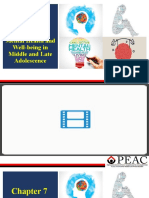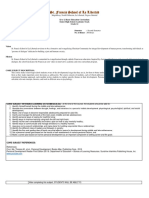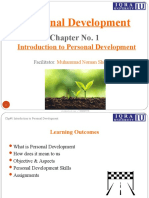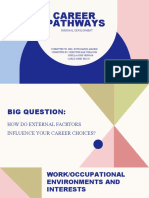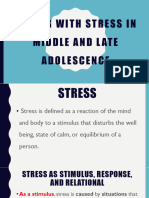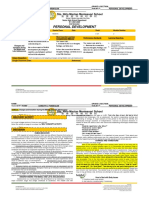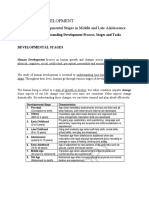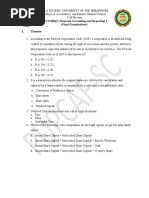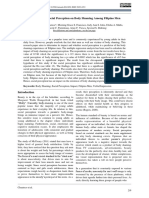Module 5 Per. Dev.
Uploaded by
Paul BandolaModule 5 Per. Dev.
Uploaded by
Paul BandolaCainta Catholic College
Cainta, Rizal
Senior High School Department
A.Y. 2020-2021
Module 5: Mental Health and Well-being in the Middle and Late Adolescence
Learning Target:
Discuss the understanding of mental health and psychological well-being to identify
ways to cope with stress during adolescence
Identify causes and effects of stress in one’s life
Demonstrate personal ways to cope with stress and maintain mental health
Mental Health and Well-being
Since the World Health Organization (WHO) introduced the concept of well-being in
1948, many different definitions of the term have been presented. The concept is
very important to a wider range of discipline, all of which have slightly different take
on it related to underlying beliefs, attitudes and practices. The term mental health is
used to describe the field which encompasses mental illness or disorder, mental well-
being and all other states of mental health.
According to WHO, “Mental Health is not just the absence of mental disorder, it is
defined as a state of well-being in which every individuals realizes his or her own
potential, feel, can cope up with the normal stresses in life, can work productively and
fruitfully, and is able to make a contribution to his or her community.”
Good mental health is the psychological state of someone who is functioning at a
satisfactory level of emotional and behavior adjustment. Mental health includes
emotional, psychological, and social well-being that affects one’s thoughts, feelings
and behaviors.
Resilience, which means “being able to cope with the normal stress in life”, is an
important component of most definition of mental well-being with great relevance for
the prevention of mental illness.
WHO Concept of Mental Health
1. Subjective Well-being
This may be defined as one’s personal (subjective) thoughts and feelings
about one’s overall state of being. Mental health denotes positive and healthy
interpretations of a person’s self-concept and emotions about him. A person
with a healthy self-concept or self-identity, exudes charm and confidence, is
usually sociable, productive and can maintain healthy relationship,
A negative self-concept will have a negative effect on one’s mental health
and well-being
MODULE FOR PERSONAL DEVELOPMENT 1
2. Perceived Self-Efficacy
Self-efficacy is one’s perception of one’s value and worth, effectiveness and
ability in performing z task or activity. Mental health and well-being is also
anchored on one’s self-worth and value or self-esteem. A person with low
self-esteem may exhibit types of behavior that are self-destructive and self-
sabotaging.
3. Autonomy
Autonomy deals with one’s capacity to separate one’s identity from other
significant person like parents, lovers and special friends. Autonomy is the
capacity for self-direction and having a clearly defined role identity. It is
crucial to have an autonomy since this defines how a person interacts with
other people and environment. Lack of autonomy, on the other hand, can lead
to co-dependence among those who cannot define themselves as a separate
entities from the people they depend on either emotionally, physically,
socially, spiritually or even financially.
4. Competence
Competence is related to self-esteem and self-identity. Competence is the
perception of one’s capacity to perform a function or activity using specific
skills and knowledge, and achieving the desired results at a given time.
5. Intergenerational Independence
Intergenerational Independence refers to the relationships between individuals
who belong to different generations but may be living separately as
independent, autonomous person during a specific period of time.
6. Self-actualization of One’s Intellectual and Emotional Potential
Maslow’s pyramid of human hierarchy of needs places the self-actualization
at the peak. This means that once a person fulfills his or her physiological
needs, security and safety needs, emotional and social needs, and self-esteem
needs, the next need to be fulfilled is the self-actualization. The fulfillment of
this needs does not have to be in sequence or progression.
Witmer and Sweeney Mental Health and Well-being Model
The model includes what is referred to as the five life tasks:
1. Essence or spirituality
2. Work and leisure
3. Friendship
4. Love
5. Self-direction
MODULE FOR PERSONAL DEVELOPMENT 2
12 Sub-task as major components of wellness or well-being
1. Sense of worth
2. Sense of control
3. Realistic beliefs
4. Emotional awareness and coping
5. Problem solving and creativity
6. Sense of humor
7. Nutrition
8. Physical exercise
9. Self-care
10. Stress management
11. Gender identity
12. Cultural identity (Note; this may or not apply to every Filipino, but we do have
cultural and regional differences that need to be understood and accepted).
It is important that the five tasks are balanced in terms of time spend on
each one, and of course on the amount of energy one gives to fulfilling
each of the tasks. The 12 sub-tasks are more of what one needs to own
and practice to achieve mental health and well-being.
Five Popular Steps to Improve mental health and well-being
1. Connect
2. Be active
3. Keep learning
4. Give to others
5. Take notice
Signs of Good Mental Health in Adolescents
Learn well in school.
Feel positive and happy about themselves.
Deal with both positive and negative emotions.
Cope and deal with the challenges of life.
Acknowledges their strengths and weaknesses.
Play contributive role in their family, peers, school and community.
Make the most of their potential.
Exercise and maintain a nutritious diet.
Enjoy plenty of sleep at night.
Few Tips for Achieving Positive Mental Health
Ventilating one’s feelings to family or close friends.
Engaging in physical activities on a regular basis.
Maintaining a nutritious diet.
Having a good sleep.
Enjoying time with family or peers.
MODULE FOR PERSONAL DEVELOPMENT 3
Having a time out.
Relaxing and enjoying a hobby.
Being positive always.
Setting realistic goals.
Asking for help when needed.
Caring for others.
Accepting oneself.
Causes of Mental Health Struggles
Hereditary
Physical factors like head injury or epilepsy that may have an impact on behavior and mood.
Unmanaged stress.
Lack of a secured or permanent home.
Negative experiences during childhood.
Being left-out.
Losing a loved one.
Poverty.
Traumatic experiences.
Signs the Teens Need Mental Health Treatment
1. Changes in mood – suffering from mood swings which he/she doesn’t usually experience.
2. Behavioral changes – irritability, depressed or getting involved in criminal activities.
3. Difficulties in school and in relationship with peers
4. Physical manifestations – general weakness, changes in eating and sleeping patterns and neglect
of self.
5. Taking medicines by oneself
Physical Development
Most girls have completed the physical changes related to puberty by age 15.
Boys are still maturing and gaining strength, muscle mass and height and are completing
the development of sexual traits.
*Most teenagers experience anxiety, confusion and discomfort about the physical changes that
happen to them. They become mindful of good grooming and looking physically attractive. Here
are some related physiological issues that may arise during this period:
Obesity – a body condition characterized by having too much body fat.
Eating Disorders – psychological conditions characterized by having extreme disturbances in
eating habits.
Three Types of Eating Disorders:
1. Anorexia Nervosa – characterized by refusal to eat. People who have this disorder see
themselves as overweight even though they are skinny. They fear gaining weight so they
exercise a lot or even starve to death.
2. Bulimia Nervosa – characterized by eating excessive amounts of food and later, purging the
body through vomiting, exercising or using laxatives or diuretics.
MODULE FOR PERSONAL DEVELOPMENT 4
3. Binge-Eating Disorder – characterized by frequent episodes of out-of-control eating. It is
quite similar to Bulimia but people with this disorder do not purge their bodies of excess
calories.
Sleep Disorders – affect the sleep quality and natural rhythm of the body.
Some Sleep Disorders Experienced by Teenagers:
1. Insomnia – refers to the trouble a person experiences in falling or staying asleep.
2. Night Owl Syndrome – changes in sleeping patterns become intense that it gets in the way of
the person’s usual tasks and routines.
3. Narcolepsy – excessive sleepiness during the day and disruption of sleep at night.
What are Mental Illnesses?
Mental illnesses are disorders of brain function.
They have many causes and result from complex interactions between a person’s genes
and their environment. Having a mental illness is not a choice or moral failing. Mental
illnesses occur at similar rates around the world, in every culture and in all socio
economic groups.
Types of Mental or Psychological Disorders
All these disorders are systematically organized and specified in the Diagnostic and
Statistical Manual of Mental Disorders (DSM V).
1. Eating Disorders
Characterized by persistent disturbance of eating that result in altered consumption of
food.
a.) Anorexia Nervosa - intense fear of gaining weight.
b.) Bulimia Nervosa – overeating; followed by efforts to induce vomiting, fasting and
excessive exercise.
c.) Binge Eating – overindulgence of food.
2. Anxiety Disorders
Characterized by excessive fear, anxiety and related behavioral disturbance.
*Phobic Anxiety - trembling, palpitations; fears seriously obstruct daily activities.
*Panic Attacks – abrupt surge of intense fear or discomfort; sweating, dizziness, chest
pains etc.
*Obsessive Compulsive Disorder (OCD) - experiences persistence of unwanted
thoughts (obsessions) and urge to engage in senseless rituals (compulsions).
3. Major Depressive Disorders
Hopelessness, lack of energy, crying for unexplained reasons and low self-esteem.
Caused by heredity, environment and stressors.
4. Bipolar Disorders
MODULE FOR PERSONAL DEVELOPMENT 5
Experience both depression and manic episodes.
5. Conduct Disorders
Repeated behaviors in which rules, policies and regulations are violated.
Teenagers who commit these are called Delinquents.
- There is a problem in establishing identity.
6. Personality Disorders
Enduring pattern of inner experience that deviates from the expectations of one’s culture.
Ex. Paranoid, Antisocial, Histrionic, Narcissistic, Avoidant
7. Psychotic Disorders
Schizophrenia – “split mind”
Exhibits delusions, hallucinations, disorganized thinking and speech and abnormal motor
behavior.
8. Substance Related Disorders
Alcohol and drug dependence.
9. Computer Addiction
Defining Stress
Stress is defined as reaction of the mind and body to a stimulus that disturbs the
well-being, state of calm, or equilibrium of a person. There is a common belief
that stress is unhealthy but discussion among experts conclude that this is not
entirely the case. Psychologist have agreed that small and sporadic amounts of
stress can be helpful and beneficial to individuals, while excessive amounts of
stress sustained over a lengthy period of time can be destructive to both physical
and mental health.
Total response of an individual to what may be perceived as harmful or dangerous
stimulus in his/her external environment.
It is experienced when an individual encounters a threat that he/she could not deal
with due to lack of proper resources.
Can be caused by external and internal factors. Internal factors can be self-
generated or came from irrational or negative thoughts.
STRESS is highly RELATIVE.
Stress as stimulus, response and relational
Stress is a stimulus as well as a rational condition between persons and the
situation they are in (Feist and Rosenberg 2012)
MODULE FOR PERSONAL DEVELOPMENT 6
As a stimulus stress is caused by situation that may be life threatening, or life
changing, such as separation, moving to a new home or having a new job.
These situation or events are often called stressor.
Stress is a response is the way the body reacts by challenging situations. This
involves the interaction between the hormones, glands, and nervous system
where the adrenal gland drives the production of cortisol or better known as
“stress hormones”.
Stress as relational is when a person experiencing stress takes a step back to
look at the situation that is causing the stress and assesses it.
IMPORTANT NOTE:
Selye (1976, p, 64) define stress as a “state manifested by a syndrome which consist
of all nonspecifically induced changes in a biologic system”. His stress model states
that a situation that threatens an organism’s well-being leads to a stereotypical
responses called General Adaptation Syndrome (GAS). The GAS theory proposed a
three-stage bodily response that is involved in adapting stress.
Stage 1- Alarm- the alarm reaction comprises an initial shock space and a
subsequent counter shock phase.
Stage 2- Resistance- the organism enters resistance stage if harmful
stimulation continues. In this stage, the symptoms of alarm reaction disappear
which seemingly indicates the organism’s adaptation to the stressor.
Stage 3- Exhaustion-the organism gives way to the stage of exhaustion if the
obnoxious stimulation continues. If the ability of the organism to adapt to the
stressor exhausted. The symptoms of the first stage would reappear but
resistance is no longer possible. This may result to irreversible tissue damage
and if the stimulation persist the organism dies,
Selye included Stage 4- return to normal in which parasympathetic nervous
system is activated and the body returns to normal state.
Sources of Stress
1. Environment
2. Social
3. Physiological
4. Thoughts
Causes of Stress
1. Family and friends
2. Life changes
3. Finances
4. Work
5. Health issues
6. Death of a loved one
7. Marital Separation
8. Personal Relationship
MODULE FOR PERSONAL DEVELOPMENT 7
9. Pregnancy
Coping with Stress
1. Keep a positive attitude
2. Accept that there are events that you cannot control
3. Learn to relax
4. Be regularly active
5. Eat well-balanced meal
6. Get enough rest and sleep
7. Identify your stressor and find effective way to cope with them
8. Avoid caffeine, alcohol and nicotine
9. Talk to someone
10. Keep a stress diary
11. Know how to take control
12. Manage your time
13. Learn to say “NO”
14. Take a rest when you are sick.
Four Types of Stress
1. Eustress – Positive stress; this gives one a feeling of fulfillment. (Ex. winning the lottery, riding a
roller coaster)
2. Distress – Negative stress; brought by unfavorable events. (Ex. losing a loved one, termination from
work)
3. Hypostress – Understress or lack of stress. (Ex. Hopelessness, boredom)
4. Hyperstress – Overstress; this happens when one is pushed beyond what he/she can handle.
What are Stressors?
- Stimuli that ignite threats, danger or tension that causes stress.
Some Possible Stressors Encountered by Adolescents
1. Search for Identity
2. Difficulty in meeting other’s expectations.
3. Strained relationship with family members.
4. Financial problem in the family.
5. Unsafe living environment.
6. Peer pressure.
7. Bullying in school.
8. School demands and pressures.
9. Career decisions.
10. Breakup with boyfriend/girlfriend.
11. Pressure to try drugs, sex or alcohol.
12. Chronic worry.
13. Negative self-talk.
14. Rigid thinking.
15. Perfectionism.
MODULE FOR PERSONAL DEVELOPMENT 8
Types of Stress Response
1. Fight – means individuals opt to confront and face the situation.
2. Flight – persons choose to run away or escape from the situation.
3. Freeze – individuals hold back, leaving all physiological reactions on hold thereby creating tension or
tremble.
Factors Influencing the Degree of Stress Tolerance
1. Support System – a solid support system of caring family members and friends can serve as a healthy
shield to protect adolescents from the storms during the transition period.
2. Sense of Control – gives adolescents the confidence to direct their lives to better manage various
stressful events.
3. Attitude and Outlook – positive thinking is a good weapon against uncertainties and difficulties in
life.
4. Ability to Deal with Emotions – being calm and maintaining one’s composure in a challenging
situation make one more resistant to stress.
5. Knowledge and Preparation – if adolescents know what to expect, the more they will be able to
prepare for such situations.
Activity 1
Directions: Watch the following videos and then answer the questions
1. http://www.youtube.com/watch?v=gtUGVzEUy5A&list=PLnqaT8j—
k62wMB_YQ9jml-7B5UwhlQyz&index-5
2. What is Mental Health? with Dr. Mike Condra
http://www.youtube.com/watch?v=aNQBdlMM3mQ
Questions:
1. What is mental health according to Dr, Mike Condra?
2. What are the things mentioned by the young people in video on how to take
care one’s mental health?
3. How mental health affects in life of an individual?
4. What are the problems you encounter everyday and how you handle it?
Criteria:
Content 5
Depth 3
Cleanliness 2
Total 10
Activity 2
Directions: Make a poster that will show how to cope up with stress
Criteria:
Content 5
Creativity 3
Cleanliness 2
Total 10
References:
Personal Development by Ricardo Rubio Santos; Rex Bookstore; pp.76-81 & pp. 104-111
MODULE FOR PERSONAL DEVELOPMENT 9
Personal Development for Senior High School by Dr. Ana Nelia L, Jumamil, RPsy, RPm:
Golden Chronica Publishing Inc., pp.83-98 & pp. 113-130
MODULE FOR PERSONAL DEVELOPMENT 10
You might also like
- Mental Health and Well-Being in Middle and Late AdolescenceNo ratings yetMental Health and Well-Being in Middle and Late Adolescence3 pages
- Signed Off Personality Developent11 q1 m4 Mental Health Well Being and Emotional Intelligence in Middle and Late Adolescence v3 RemovedNo ratings yetSigned Off Personality Developent11 q1 m4 Mental Health Well Being and Emotional Intelligence in Middle and Late Adolescence v3 Removed23 pages
- Module in Perdev - Emotional IntelligenceNo ratings yetModule in Perdev - Emotional Intelligence9 pages
- Insights Into One's Personal DevelopmentNo ratings yetInsights Into One's Personal Development20 pages
- The Challenges of Middle and Late AdolescenceNo ratings yetThe Challenges of Middle and Late Adolescence9 pages
- Coping With Stress in Middle and Late Adolescence100% (2)Coping With Stress in Middle and Late Adolescence21 pages
- Department of Education Region III Division of Pampanga Basa Air Base National High School Floridablanca, Pampanga S.Y. 2019 - 2020No ratings yetDepartment of Education Region III Division of Pampanga Basa Air Base National High School Floridablanca, Pampanga S.Y. 2019 - 20202 pages
- L Earning Activity Sheet - PERDEV 12: Learning Competency With Code: Discuss That Understanding The IntensityNo ratings yetL Earning Activity Sheet - PERDEV 12: Learning Competency With Code: Discuss That Understanding The Intensity13 pages
- Lesson 2.2 - Developing The Whole PersonNo ratings yetLesson 2.2 - Developing The Whole Person33 pages
- Developmental Stages in Middle and Late Adolescence100% (1)Developmental Stages in Middle and Late Adolescence14 pages
- Chapter 6 Coping With Stress in Middle and Late AdolescenceNo ratings yetChapter 6 Coping With Stress in Middle and Late Adolescence28 pages
- Personal Development: Maria Dina G. TayactacNo ratings yetPersonal Development: Maria Dina G. Tayactac26 pages
- Lesson Plan in Personal Development July 17No ratings yetLesson Plan in Personal Development July 173 pages
- Bulan National High School: Personal Development 12No ratings yetBulan National High School: Personal Development 127 pages
- Module 3 Developmetal Stages in Middle and Late AdolescenceNo ratings yetModule 3 Developmetal Stages in Middle and Late Adolescence61 pages
- Personal Development: Quarter 4 - Week 8 Insights Into One's Personal DevelopmentNo ratings yetPersonal Development: Quarter 4 - Week 8 Insights Into One's Personal Development15 pages
- MODULE 3 DEVELPOPMENTAL STAGES AND CHALLENGES OF MIDDLE AND LATE ADOLESCENCE Wk.3 PDFNo ratings yetMODULE 3 DEVELPOPMENTAL STAGES AND CHALLENGES OF MIDDLE AND LATE ADOLESCENCE Wk.3 PDF15 pages
- PERDEV Handout - M6 (Powers of The Mind)No ratings yetPERDEV Handout - M6 (Powers of The Mind)2 pages
- Personality Development Weeks 1-2 ModuleNo ratings yetPersonality Development Weeks 1-2 Module13 pages
- Darlene David - 12 - STEM-2 - PERDEV-Module-Quarter-2-Week-6100% (2)Darlene David - 12 - STEM-2 - PERDEV-Module-Quarter-2-Week-64 pages
- Development Stages in Middle and Late AdNo ratings yetDevelopment Stages in Middle and Late Ad76 pages
- Challenges in Middle and Late AdolescenceNo ratings yetChallenges in Middle and Late Adolescence22 pages
- Mental Health and Well-Being in Middle and Late Adolescence.100% (7)Mental Health and Well-Being in Middle and Late Adolescence.22 pages
- ACCO 20043 Financial Accounting and Reporting 2 FinalsNo ratings yetACCO 20043 Financial Accounting and Reporting 2 Finals16 pages
- X C X X C: Measure of Central Tendency - Grouped DataNo ratings yetX C X X C: Measure of Central Tendency - Grouped Data4 pages
- Activity 9-11 Fundamental-Movement-PatternNo ratings yetActivity 9-11 Fundamental-Movement-Pattern4 pages
- PerDev LAS 12 Challenges During Adolescence 2No ratings yetPerDev LAS 12 Challenges During Adolescence 21 page
- MODULE 8 - Practice Test No. 10 - HomeworkNo ratings yetMODULE 8 - Practice Test No. 10 - Homework6 pages
- The Problem and A Review of Related Literature and Studies: Bagong Barrio National High School-AnnexNo ratings yetThe Problem and A Review of Related Literature and Studies: Bagong Barrio National High School-Annex56 pages
- Relationship Between Emotional Intelligence and Self Esteem Among Pakistani University Students 2161 0487 1000279No ratings yetRelationship Between Emotional Intelligence and Self Esteem Among Pakistani University Students 2161 0487 10002796 pages
- The Impact of Extra-Curricular Activities in The Personal Development of The Members of Performing Groups of Philippine Normal University-North LuzonNo ratings yetThe Impact of Extra-Curricular Activities in The Personal Development of The Members of Performing Groups of Philippine Normal University-North Luzon18 pages
- The Effects of Laziness On The Academic Performance of Junior High School Students at Antipolo National High School During The School Year 2022-2023No ratings yetThe Effects of Laziness On The Academic Performance of Junior High School Students at Antipolo National High School During The School Year 2022-202313 pages
- The Relationship Between Mental Health, Acculturative Stress, and Academic Performance in A Latino Middle School SampleNo ratings yetThe Relationship Between Mental Health, Acculturative Stress, and Academic Performance in A Latino Middle School Sample10 pages
- Physiological Needs - : Examples: - Air, Food, Drink, Shelter, Clothing, Warmth, Sex, SleepNo ratings yetPhysiological Needs - : Examples: - Air, Food, Drink, Shelter, Clothing, Warmth, Sex, Sleep2 pages
- Drawing The Ideal Self: Session PR Ompt SheetNo ratings yetDrawing The Ideal Self: Session PR Ompt Sheet5 pages
- A Study of Self-Confidence and Inferiority-Insecurity Feeling As Related To Academic AchievementNo ratings yetA Study of Self-Confidence and Inferiority-Insecurity Feeling As Related To Academic Achievement105 pages
- The Impact of Social Perception On Body Shaming Among Filipino MenNo ratings yetThe Impact of Social Perception On Body Shaming Among Filipino Men8 pages
- Developing Leadership Skills Among Adolescents and Young Adults A Review of Leadership ProgrammesNo ratings yetDeveloping Leadership Skills Among Adolescents and Young Adults A Review of Leadership Programmes14 pages
- The Influence of Social Media on MurderNo ratings yetThe Influence of Social Media on Murder102 pages
- Mental Health and Well-Being in Middle and Late AdolescenceMental Health and Well-Being in Middle and Late Adolescence
- Signed Off Personality Developent11 q1 m4 Mental Health Well Being and Emotional Intelligence in Middle and Late Adolescence v3 RemovedSigned Off Personality Developent11 q1 m4 Mental Health Well Being and Emotional Intelligence in Middle and Late Adolescence v3 Removed
- Department of Education Region III Division of Pampanga Basa Air Base National High School Floridablanca, Pampanga S.Y. 2019 - 2020Department of Education Region III Division of Pampanga Basa Air Base National High School Floridablanca, Pampanga S.Y. 2019 - 2020
- L Earning Activity Sheet - PERDEV 12: Learning Competency With Code: Discuss That Understanding The IntensityL Earning Activity Sheet - PERDEV 12: Learning Competency With Code: Discuss That Understanding The Intensity
- Developmental Stages in Middle and Late AdolescenceDevelopmental Stages in Middle and Late Adolescence
- Chapter 6 Coping With Stress in Middle and Late AdolescenceChapter 6 Coping With Stress in Middle and Late Adolescence
- Bulan National High School: Personal Development 12Bulan National High School: Personal Development 12
- Module 3 Developmetal Stages in Middle and Late AdolescenceModule 3 Developmetal Stages in Middle and Late Adolescence
- Personal Development: Quarter 4 - Week 8 Insights Into One's Personal DevelopmentPersonal Development: Quarter 4 - Week 8 Insights Into One's Personal Development
- MODULE 3 DEVELPOPMENTAL STAGES AND CHALLENGES OF MIDDLE AND LATE ADOLESCENCE Wk.3 PDFMODULE 3 DEVELPOPMENTAL STAGES AND CHALLENGES OF MIDDLE AND LATE ADOLESCENCE Wk.3 PDF
- Darlene David - 12 - STEM-2 - PERDEV-Module-Quarter-2-Week-6Darlene David - 12 - STEM-2 - PERDEV-Module-Quarter-2-Week-6
- Mental Health and Well-Being in Middle and Late Adolescence.Mental Health and Well-Being in Middle and Late Adolescence.
- ACCO 20043 Financial Accounting and Reporting 2 FinalsACCO 20043 Financial Accounting and Reporting 2 Finals
- X C X X C: Measure of Central Tendency - Grouped DataX C X X C: Measure of Central Tendency - Grouped Data
- The Problem and A Review of Related Literature and Studies: Bagong Barrio National High School-AnnexThe Problem and A Review of Related Literature and Studies: Bagong Barrio National High School-Annex
- Relationship Between Emotional Intelligence and Self Esteem Among Pakistani University Students 2161 0487 1000279Relationship Between Emotional Intelligence and Self Esteem Among Pakistani University Students 2161 0487 1000279
- The Impact of Extra-Curricular Activities in The Personal Development of The Members of Performing Groups of Philippine Normal University-North LuzonThe Impact of Extra-Curricular Activities in The Personal Development of The Members of Performing Groups of Philippine Normal University-North Luzon
- The Effects of Laziness On The Academic Performance of Junior High School Students at Antipolo National High School During The School Year 2022-2023The Effects of Laziness On The Academic Performance of Junior High School Students at Antipolo National High School During The School Year 2022-2023
- The Relationship Between Mental Health, Acculturative Stress, and Academic Performance in A Latino Middle School SampleThe Relationship Between Mental Health, Acculturative Stress, and Academic Performance in A Latino Middle School Sample
- Physiological Needs - : Examples: - Air, Food, Drink, Shelter, Clothing, Warmth, Sex, SleepPhysiological Needs - : Examples: - Air, Food, Drink, Shelter, Clothing, Warmth, Sex, Sleep
- A Study of Self-Confidence and Inferiority-Insecurity Feeling As Related To Academic AchievementA Study of Self-Confidence and Inferiority-Insecurity Feeling As Related To Academic Achievement
- The Impact of Social Perception On Body Shaming Among Filipino MenThe Impact of Social Perception On Body Shaming Among Filipino Men
- Developing Leadership Skills Among Adolescents and Young Adults A Review of Leadership ProgrammesDeveloping Leadership Skills Among Adolescents and Young Adults A Review of Leadership Programmes







